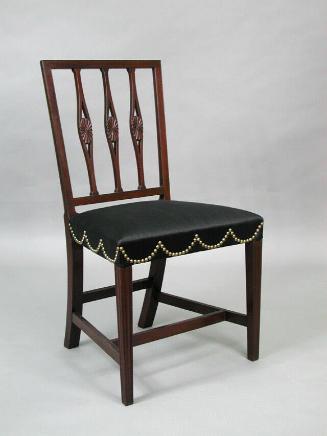Armchair
Original OwnerOriginally owned by
Roger Sherman
(American, 1721 - 1793)
Furniture MakerMade by
Unknown
Dateabout 1790
MediumCherry, pine, leather, brass nails
DimensionsPrimary Dimensions (overall height x width x depth): 37 1/4 x 24 3/8 x 20in. (94.6 x 61.9 x 50.8cm)
ClassificationsFurniture
Credit LineConnecticut Museum of Culture and History collection
Object number1841.57.0
DescriptionCherry armchair in the Federal, or early neoclassical, style, with a flat crest rail, four straight banisters, tapered front legs, and leather over-the-rails upholstery. The back of the chair is formed by a straight crest rail atop two stiles; the stiles are raked, or angled, together slightly from top to bottom. Four vertical banisters are evenly spaced below the crest rail; these are also raked together slightly from top to bottom. Above the seat, each stile is slanted backwards. Below the seat, each stile forms a leg that slants toward the center back of the chair; each leg terminates in a foot that slants still more sharply back. Each arm undulates, with a flat handhold that extends past the side seat rails. The arm is supported by a curved arm support that extends down to the side seat rail, just behind the front leg. The seat is trapezoidal, with black over-the-rails upholstery. The upholstery is held in place with a line of brass nails along the bottom and side edge of the front seat rail, and along the bottom and back edge of the side seat rails. The tapered front legs extend from the height of the seat down to the foot. All four sides of the chair have a plain, rectangular stretcher connecting the legs.
Condition: The lower portion of the front legs and the front stretcher are well worn and scratched. The interior lower edge of the left arm has multiple small gouges. The top edge of each side seat rail has begun to split. The upholstery is replaced; only a small amount of the thin mesh that was applied to the underside of the seat rail remains under the upholstery nails.
Design and Construction Details:
Design. A thin line of cock beading extends up the sides of each stile, above the seat, and onto the sides and top of the crest rail. The back lower edge of the crest rail is canted. A rail nailed down onto the back seat rail has a cove-molded front, with a thin line of cock beading at the top edge.
Chair Frame. The crest rail is supported by a tenon at the top of each stile. Above the seat, the back of each stile is rounded. Each banister is tapered slightly from top to bottom, and each is tenoned into the crest rail above and into the back seat rail below. A molded rail is nailed down onto the back seat rail at the bottom of the banisters; the back of the rail has four cut-outs to accommodate the bottom of the banisters. The back of each arm is screwed into the stile. The front of each arm is supported on a tenon at the top of the arm support. Each arm support is screwed into the side seat rail, just ahead of the center of the rail. The back seat rail is tenoned into the stiles. Each side seat rail is tenoned through the stile; each of these joints is secured with two small wedges inserted into the back of the tenon. Each interior back corner of the seat frame has a vertical, triangular corner block. Each interior front corner of the seat frame has a vertical glue block and a triangular corner block. The corner blocks are each held in place with two nails. The joints where the front and side seat rails meet the front legs are concealed. Each stretcher is tenoned into the lower legs.
Upholstery (replaced). The armchair is upholstered with over-the-rails black leather. The leather is held in place with a row of brass nails along the lower edge of the front and side seat rails, and up the outside front edge of each front leg. Below the leather is stuffing, sackcloth, and canvas webbing that is tacked directly to the top of the seat rails. The bottom edges of the seat rails each have a row of small nails; at one time, these nails secured a thin mesh to the underside of the seat (now only remnants are left).
NotesOwner Note: Roger Sherman (1721-1793) was a signer of the Declaration of Independence.Condition: The lower portion of the front legs and the front stretcher are well worn and scratched. The interior lower edge of the left arm has multiple small gouges. The top edge of each side seat rail has begun to split. The upholstery is replaced; only a small amount of the thin mesh that was applied to the underside of the seat rail remains under the upholstery nails.
Design and Construction Details:
Design. A thin line of cock beading extends up the sides of each stile, above the seat, and onto the sides and top of the crest rail. The back lower edge of the crest rail is canted. A rail nailed down onto the back seat rail has a cove-molded front, with a thin line of cock beading at the top edge.
Chair Frame. The crest rail is supported by a tenon at the top of each stile. Above the seat, the back of each stile is rounded. Each banister is tapered slightly from top to bottom, and each is tenoned into the crest rail above and into the back seat rail below. A molded rail is nailed down onto the back seat rail at the bottom of the banisters; the back of the rail has four cut-outs to accommodate the bottom of the banisters. The back of each arm is screwed into the stile. The front of each arm is supported on a tenon at the top of the arm support. Each arm support is screwed into the side seat rail, just ahead of the center of the rail. The back seat rail is tenoned into the stiles. Each side seat rail is tenoned through the stile; each of these joints is secured with two small wedges inserted into the back of the tenon. Each interior back corner of the seat frame has a vertical, triangular corner block. Each interior front corner of the seat frame has a vertical glue block and a triangular corner block. The corner blocks are each held in place with two nails. The joints where the front and side seat rails meet the front legs are concealed. Each stretcher is tenoned into the lower legs.
Upholstery (replaced). The armchair is upholstered with over-the-rails black leather. The leather is held in place with a row of brass nails along the lower edge of the front and side seat rails, and up the outside front edge of each front leg. Below the leather is stuffing, sackcloth, and canvas webbing that is tacked directly to the top of the seat rails. The bottom edges of the seat rails each have a row of small nails; at one time, these nails secured a thin mesh to the underside of the seat (now only remnants are left).
Status
Not on view












